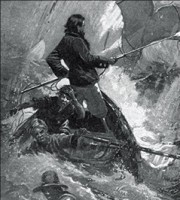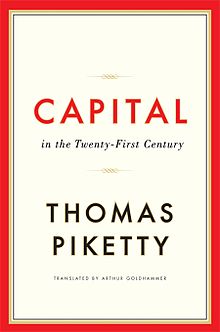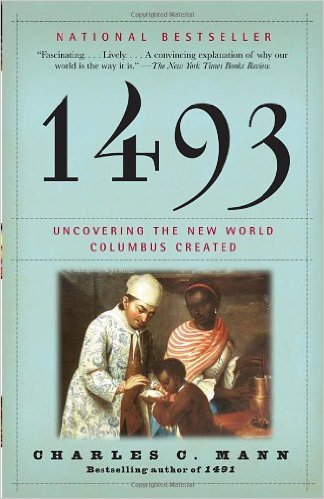 Everyone knows about that time Tom Sawyer tricked the neighborhood kids into painting his aunt’s fence for him. Everyone knows about his time hiding out on Jackson Island with his friend Huck Finn and when he made his way out of McDougal’s Cave with his sweetheart Becky. Heck, those who have read Adventures of Huckleberry Finn could even tell you that Tom Sawyer was there when Huck Finn freed the slave Jim after he is recaptured. Tom Sawyer’s story has been a part of not only the literary canon, but a part of the American tale we tell ourselves. But few know about that one time Tom Sawyer, Huck Finn, and Jim hopped on a flying machine with a deranged inventor and made their way over to Northern Africa.
Everyone knows about that time Tom Sawyer tricked the neighborhood kids into painting his aunt’s fence for him. Everyone knows about his time hiding out on Jackson Island with his friend Huck Finn and when he made his way out of McDougal’s Cave with his sweetheart Becky. Heck, those who have read Adventures of Huckleberry Finn could even tell you that Tom Sawyer was there when Huck Finn freed the slave Jim after he is recaptured. Tom Sawyer’s story has been a part of not only the literary canon, but a part of the American tale we tell ourselves. But few know about that one time Tom Sawyer, Huck Finn, and Jim hopped on a flying machine with a deranged inventor and made their way over to Northern Africa.
It turns out that The Adventures of Huckleberry Finn is not the end of the Tom and Huck saga. Mark Twain completed two other novels focused on his two most famous characters, Tom Sawyer Abroad and Tom Sawyer Detective. Twain even attempted to write other adventure tales featuring Tom and Huck, including Huck and Tom Among the Indians, Schoolhouse Hill, and Tom Sawyer’s Conspiracy, but none of these were published or even completed in Twain’s lifetime.
There’s a reason why Tom Sawyer Abroad failed to lodge in America’s consciousness: it’s not great. I suppose you could see it as the Solo: A Star Wars Story of the Tom Sawyer series, or Twain’s Caravan of Courage: An Ewok Adventure, if you’re being unkind. While the previous Tom and Huck stories weren’t exactly concerned with narrative realism, it does seem odd to see Twain inject some Jules Verne steampunk into the bucolic world of St. Petersburg, Missouri.
Like The Adventures of Huckleberry Finn, Abroad is narrated by Huck, and though published about a decade after Huck Finn, it begins almost immediately after the events of the previous novel. The first chapter, “Tom Seeks New Adventures,” which begins with Tom Sawyer deciding that the events of Huck Finn wouldn’t be enough to satiate his curiosity and wanderlust, seems to perfectly describe what was likely Twain’s brainstorming process. As M. Thomas Inge notes in my edition’s afterward, Twain, who got himself into financial trouble towards the end of the nineteenth century, wrote Abroad for “crass commercial purposes.” In other words Twain writing a third novel featuring these characters is kind of like when a movie studio decides that they have some IP that they can squeeze a few bucks from. So I guess this makes Tom Sawyer Abroad the Live Free or Die Hard or the Wall Street: Money Never Sleeps or Godfather III of Twain’s oeuvre.
And just like many movie studios of late, Twain had been bitten by the franchise bug. He apparently had plans to ship Huck, Tom, and Jim to other parts of the world in a series of sequels, which never came to be. Judging by the quality of Abroad, this is probably for the better. The main problem is that although Abroad promises lots of hijinks by Tom, Huck, and Jim in Northern Africa, the trio doesn’t really spend much time actually on the ground. Instead, they spend much of the early chapters terrorized by the manic mad inventor of the airship who both seems to have absolute faith in his invention and a streak of misanthropy, and when he plunges to his grizzly death, the three of them are left to figure out what to do now that they’ve somehow wandered across the Atlantic Ocean. But once they reach Africa, they mostly just hang out in the stupid air balloon. There’s no awkward mix up with local customs or getting caught up in the tension between the Berbers and colonizing European powers. No, it’s mostly just Tom, Huck, and Jim observing things from a far and shooting the shit.

On the bright side, the conversation and arguments that the three get into are without a doubt the highlights of the novel. As the most learned of the three, Tom repeatedly tries to represent himself and worldly and authoritative, but he’s almost always rhetorically outmaneuvered by Jim. At one point they consider the implication that fleas are proportionally much stronger than humans, leading them to the horrifying conclusion that if a flea were human-size, then that “flea would be President of the United States, and you couldn’t any more prevent it than you can prevent lightning.” In these moments, you can feel Twain’s warmth towards his creations, and the book starts to take the shape of an anti-adventure novel, where the characters go halfway around the world just to get into philosophical arguments with one another. Maybe Richard Linklater can do the film adaptation.
It’s worth highlighting the boisterous illustrations, which are admittedly a lot of fun, and interestingly enough they were created by Dan Beard, an early founder of the Boy Scouts of America.
Tom Sawyer Abroad is uneven at best, but that doesn’t mean that there’s not some interesting work going on here. The novel showcases Twain’s burgeoning anti-imperialist attitudes. Early on, Tom tries to convince his companions to embark on a crusade, but Jim is unsure about the ethics behind this new idea, arguing that if he had a farm and someone wanted it, it wouldn’t be right for them to just take it like the so called crusaders. Apoplectic, Tom rejects Jim’s metaphor outright:
“It ain’t a farm, it’s entirely different. You see, it’s like this. They own the land, just the mere land, and that’s all they do own; but it was our folks, our Jews and Christians, that made it holy, and so they haven’t any business to be there defiling it.”
Tom’s response surely strikes the reader as an inefficient defense of crusades, but it also inaugurates themes of epistemological uncertainty and imperialism. He rejects Jim’s metaphor as a means of knowing how Middle Easterners must have felt about invading Europeans. Throughout the novel the notion of metaphors as a means of knowing comes into play, which in turn affects how the trio see themselves as an invasive force.
Later, after the three have been riding the balloon across America, Huck uses his knowledge of of maps to try and pinpoint exactly where they are. Although they have been riding the balloon for quite some time, Huck’s surprised that they haven’t passed into Indiana yet. When asked why he thinks they haven’t passed Indiana yet, Huck logically observes that while the state of Illinois is green, Indiana is clearly pink. After all, that’s how it’s portrayed on maps he’s seen. Like the metaphor of the farm, Huck is relying on the map as a form of metaphor. It synecdochically stands in for the nation as a whole, but where Jim’s farm metaphor attempts the bridge the distance between Christians and Muslims, the map demonstrates ways in which metaphor can distance us from the reality of the object itself. Color coded states are a helpful shorthand, but they are clearly a fiction.
There’s a running theme of how distance, both figurative and literal, between us and the other becomes difficult to bridge through traditional modes of knowledge production. While reading Tom Sawyer Abroad, I eventually became frustrated by the fact that Tom, Huck, and Jim rarely leave the damn balloon. One of the joys of these globetrotting nineteenth century adventure stories is how our western heroes get to visit new places and cultures. Of course, these cultures are always interpreted through the understanding of the white authors, often in wildly inaccurate and racist ways. But if we’re to look at Abroad as an anti-adventure novel, perhaps this is the point. There’s no uncovering of ancient artifacts from lost civilizations or opportunities to use superior wit to escape capture by the natives. Instead, the three of them much prefer to sit around and jaw with one another just as if the front porches of St. Petersburg, Missouri were transported to the Sahara Desert.
Because Tom, Huck, and Jim rarely leave the balloon, they have a skewed perspective understanding of Africa and its people. It’s telling that Twain borrows the word “aeronaut” from Jules Verne, who he is clearly satirizing, but here he spells it “errornaut” (italics mine).
To me, this seems to suggest ways in which this new technology allows individuals to more quickly and easily cast about the world while also maintaining a distance from the actual people who live in these “far flung” regions, keeping us just as ignorant as before we left our provincial town. I can’t help but compare the balloon in Abroad with drones sent by the military to places like Northern Africa and the Middle East.
We see both of these issues, the use of metaphor as knowledge-creation and the errornautical view of the world, collide in the chapter, “The Sand-Storm,” where the trio witnesses the destruction of a caravan of nomads violently tossed by a sandstorm. Tom and company were devastated by these deaths and felt like they had lost friends although they never actually met any members of the caravan.
For some time, the trio had followed the caravan with their air balloon, and as Tom says, “The longer we traveled with them, and the more we got used to their ways, the better and better we liked them.” Of course, they didn’t actually know any of the Africans below, so they granted them names, like “Mr. Elexander Robinson and Miss Adaline Robinson” or “Miss Harryet McDougal.” Over time, the group became so familiar with these nomads that they decided it was okay to drop the misters and misses and other titles. Once again, Abroad is trapped between the remote and the nearby. Tom and the rest are capable of extending empathy towards outsiders from a culture and place foreign to them, but in order to do so, they must Anglicize these people. The Africans become Robinsons and McDougals.
 Over the course of the novel, Tom, Huck, and Jim become accidental imperialists. At one point, Tom looks at all the sand that’s been gathering in their balloon and decides that it must be worth tens of thousands of dollars. Quickly, he sets upon a money-making scheme:
Over the course of the novel, Tom, Huck, and Jim become accidental imperialists. At one point, Tom looks at all the sand that’s been gathering in their balloon and decides that it must be worth tens of thousands of dollars. Quickly, he sets upon a money-making scheme:
“[W]e can keep on coming back and fetching sand, and coming back and fetching more sand, and just keep it a-going till we’ve carted this whole desert over there and sold it out; and there ain’t ever going to be any opposition, either because we’ll take out a patent.”
The only thing that preventing Tom from embarking on literally stealing the desert sands of North Africa are tariffs, which he reasons would completely eat away at their profits.
But just as it’s easy to not only forgive Tom’s fence-painting scheme, but actually laud him for his ingenuity, Tom, Huck, and Jim are so genial, it’s easy to forgive or miss altogether the fact that they seem to be inadvertently colonizing countries they likely didn’t even know existed at the beginning of the novel. Needless to say, Tom Sawyer Abroad is a strange novel. I don’t think anyone expected Mark Twain to pump out a steampunk sequel to The Adventures of Tom Sawyer and Huckleberry Finn, and after reading the novel, I’m not surprised that it’s fallen into obscurity. Despite the fact that the novel spans oceans and deserts, it seems strangely stagnant and claustrophobic. The novel is filled with contradictions like this, but in many ways Tom Sawyer Abroad is the kind of novel you enjoy the more you think and write about it.

I do think that there’s a lot of potential to adapt Tom Sawyer Abroad as a film. Hear me out. There’s no definitive film version of either Tom Sawyer or Huck Finn, perhaps the closest being the 1938 technicolor adaptation. For whatever reason, both novels seem to resist adaptation, perhaps because of their episodic structure. But what’s the use in letting these instantly recognizable IPs lying around? People have heard of Huck Finn and Tom Sawyer, and they’re in the public domain. Do I have to draw you a map?
But in all seriousness, I would be down for a steampunk, globe-trotting Tom Sawyer movie. And since the novel isn’t as precious as the first two, a screenwriter doesn’t really have any obligation to follow the book to the letter. It’s an invitation to let your imagination go wild. If Hollywood wanted to play it safe, they could just let Guy Ritchie do to Tom Sawyer what he already did to Sherlock Holmes. But I also think both Kings of Summer and Kong make Jordan Vogt-Roberts uniquely qualified for steampunk Tom Sawyer. This one’s for free, Hollywood.

 It wouldn’t be a stretch to say Hillbilly Elegy benefited from some good timing. Released a little over four months before the Electoral College ushered Donald J. Trump into the White House, J.D. Vance’s memoir was within easy reach and memory for pundits and journalists who wanted to figure out the once unthinkable event of Trump becoming president of the United States. Trump was able to flip a number of midwestern states thanks to an increased support in the rust belt and Appalachia, and here was a memoir attempting to explain, through the author’s experience, the mindset and problems facing this often ignored population.
It wouldn’t be a stretch to say Hillbilly Elegy benefited from some good timing. Released a little over four months before the Electoral College ushered Donald J. Trump into the White House, J.D. Vance’s memoir was within easy reach and memory for pundits and journalists who wanted to figure out the once unthinkable event of Trump becoming president of the United States. Trump was able to flip a number of midwestern states thanks to an increased support in the rust belt and Appalachia, and here was a memoir attempting to explain, through the author’s experience, the mindset and problems facing this often ignored population.
 Robert W. Chambers has become an apparition in American literature. He’s barely read anymore, but we can feel his ghostly presence across dimensions, mostly through his influence on writers like H.P. Lovecraft whose popularity has only increased in recent years thanks to the
Robert W. Chambers has become an apparition in American literature. He’s barely read anymore, but we can feel his ghostly presence across dimensions, mostly through his influence on writers like H.P. Lovecraft whose popularity has only increased in recent years thanks to the  It’s not often that a densely researched academic text enters the national conversation. Often there’s a thick barrier between academic and public discourse. The only means to break through this divide is to funnel research that’s important to the public into a more easily digestible op-ed. But the idea that an economist could get the general public to run out and purchase a 600-plus page tome that pores through centuries of data on income inequality seems especially improbable in our day and age of bit-sized digital text and information. Thomas Piketty’s Capital in the Twenty-First Century, whose English translation came out in 2014, is that 600-plus page tome. And while Piketty’s centuries spanning analysis of income inequality isn’t exactly a beach read, it’s also clear that Piketty believes his work is important enough for a non-academic audience and clearly wrote his study so that it could be read by anyone willing to put in a little elbow grease.
It’s not often that a densely researched academic text enters the national conversation. Often there’s a thick barrier between academic and public discourse. The only means to break through this divide is to funnel research that’s important to the public into a more easily digestible op-ed. But the idea that an economist could get the general public to run out and purchase a 600-plus page tome that pores through centuries of data on income inequality seems especially improbable in our day and age of bit-sized digital text and information. Thomas Piketty’s Capital in the Twenty-First Century, whose English translation came out in 2014, is that 600-plus page tome. And while Piketty’s centuries spanning analysis of income inequality isn’t exactly a beach read, it’s also clear that Piketty believes his work is important enough for a non-academic audience and clearly wrote his study so that it could be read by anyone willing to put in a little elbow grease. What is globalization? The answer may seem pretty obvious, especially in an age when “globalization” has become a buzzword. We might simply define globalization as a process that involves technology’s ability to shrink time and distance, connect the world economy, and weaken state sovereignty. In Charles C. Mann’s 1493, he makes the sensible argument that globalization’s roots stretch back all the way to Columbus’s stumble onto the Americas. In academia, this idea goes back at least forty years and is known as the Columbian Exchange. However, Mann’s understanding of globalization carries with it an ideological subtext that affects his understanding of this five hundred year development. For Mann, globalization isn’t a process that could lead to multiple worldwide outcomes. He sees globalization solely as the global movement towards laissez faire capitalism while ignoring alternative possibilities that might arise from our ever shrinking world.
What is globalization? The answer may seem pretty obvious, especially in an age when “globalization” has become a buzzword. We might simply define globalization as a process that involves technology’s ability to shrink time and distance, connect the world economy, and weaken state sovereignty. In Charles C. Mann’s 1493, he makes the sensible argument that globalization’s roots stretch back all the way to Columbus’s stumble onto the Americas. In academia, this idea goes back at least forty years and is known as the Columbian Exchange. However, Mann’s understanding of globalization carries with it an ideological subtext that affects his understanding of this five hundred year development. For Mann, globalization isn’t a process that could lead to multiple worldwide outcomes. He sees globalization solely as the global movement towards laissez faire capitalism while ignoring alternative possibilities that might arise from our ever shrinking world.